Humcha
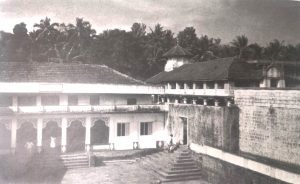 Main Jaina temple at Humcha. On the left the residence of the Bhattaraka. Two further buildings on the left (not shown here) contain a library and rooms for pilgrims and visitors.
Main Jaina temple at Humcha. On the left the residence of the Bhattaraka. Two further buildings on the left (not shown here) contain a library and rooms for pilgrims and visitors.
The history of Humcha (also Hombuja), a quiet, unobtrusive township and seat of a Jaina Bhattaraka (see next page), began about 1300 years ago with the arrival of Jinadatta, a royal prince of Mathura in the north, who had to flee his home city for family reasons.
Karnataka is known as the home of great story-tellers, and thus, in the course of the centuries, the account of prince Jinadatta’s flight southward at the counsel of his guru Muni Siddhanta, a Jaina Digambara monk, grew into an embellished but rather long and complicated tale of adventure in which Padmavati, that popular goddess who likes to employ ways and means not easily understood by humans, plays the
mayor part. Heeding further advice from his guru, Jinadatta took a statue of Padmavati, strapped to his back, with him on his long journey south; she would protect him against dangers, the muni had told him.
One day, on his long flight on horseback, at a place where Humcha’s famous Lakki tree still grows from under the feet of the Padmavati image, the story continues, Jinadatta, while resting in the shade of a tree. had a dream in which he was told “to establish his capital at this place with the help of the people living round in the jungle.”
Jinadatta did what he was asked to do:: he founded a city, built two temples in honour of the Tirthankaras, spread peace and amity among the local people and made Padmavati the presiding deity of what soon became – and is to the present daya kshetra or tirtha, a sacred pil- grims’ place.
The settlement prospered, and the princes in the line of Jinadatta continued to rule over this tiny kingdom for centuries. At some stage, however, the capital was transferred from Humcha to a place called Kalasa
None of the small southern king- doms withstood the political upheavals brought about by the invasion of Muslim forces from the north, but at Humcha
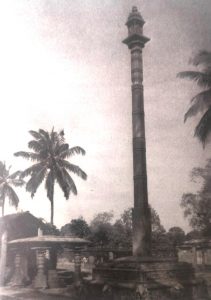 Humcha. An elegant manastambha in front of an old temple of modest size. The sculpture on the top represents Brahma. More often these pillars are crowned by a Jina. and some other places the Digambara Bhattaraka tradition has been kept alive till
Humcha. An elegant manastambha in front of an old temple of modest size. The sculpture on the top represents Brahma. More often these pillars are crowned by a Jina. and some other places the Digambara Bhattaraka tradition has been kept alive till
now (see map, page 28). The present Bhattaraka of Humcha who bears the title Devendrakirthi Swamigal was traditionally chosen by his predecessor and installed in 1971 at the age of twenty- two.
He is both an able conservator of Jaina traditions and values as well as an enterprising innovator in fields such as education and social welfare, and he is one of the as vet small number of Jainas who take an active interest in making Jainism better known in the world.
Foreign visitors to Humcha who would like to stay for some time and learn the basic tenets of the Jaina religion and philosophy are wel- come.
The peaceful environment, the five temples with their sculptural treasures, and a library make Humcha an ideal retreat for study and meditation. Though situated at a rather far distance from the nearest interstate highway, this small town is well served with state and private busses (for address see appendix).
The Bhattaraka tradition
In the fourfold division of the Jaina society consisting of shravakas (male laity), shravikas (female laity), sadhus (monks) and sadhvis (nuns), the Bhattaraka, a specific Digambara institution, is placed above the laity but below the ascetics.
He resides in a permanent domicile called matha, a term generally rendered ‘monastery (which is rather misleading), and is committed to living a celibate life. He uses, like a fully ordained monk, a fly-whisk made of peacock feathers but wears three pieces of clothing. However, he need not pluck his hair and may travel by any kind of transport.
His main duties lie in the fields of education, social and medical welfare, in fostering amity among the members of the community, and in keeping religious rites and traditions alive. Further, he is expected to be well versed in matters of doctrines and sacred law as well as being an able administrator and negotiator when it comes to settling disputes with local or state governments.
Traditionally, a Bhattaraka nominates his successor, almost always from among his disciples. If for any reason he fails to do that, a committee of lay-people will se- lect a new Bhattaraka. When death approaches, the custom prevails that a Bhattaraka will discard his three pieces of clothing, so that he may die the death of an ordained monk, that is, naked.
The Bhattaraka tradition is believed to have originated during the eighth century; however, of the once thirty-six seats of Bhattarakas only eleven still exist: one each in Rajasthan and Tamilnadu, three in Maharashtra and six in Karnataka.
Paying one’s respects to a Bhattaraka when visiting a respective place of pilgrim- age, is a well received gesture. There are strong minded and colourful men among these religious leaders.
A selection of Humcha’s art treasures:
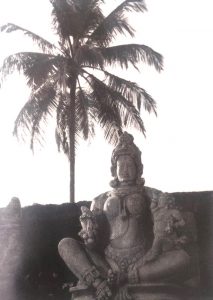 Ambika, with child and a bunch of mangoes. A boldly but none- theless masterly carved image of this popular goddess. It shares the
Ambika, with child and a bunch of mangoes. A boldly but none- theless masterly carved image of this popular goddess. It shares the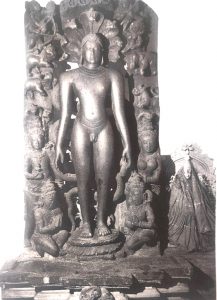 wide open eyes with the Bahubali below (ill. 50).
wide open eyes with the Bahubali below (ill. 50).
Parshvanatha, guarded against the attack by Kamatha and his horde of ferocious animals by the snake-god whom he once saved from being burned. A fine piece of sacred art (for a close-up see page 6). Late ninth century.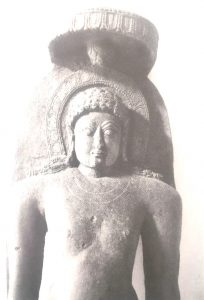
Detail of an early statue of Bahubali. Ninth/tenth century. The debris of the temple in which it once stood are being stored for future rebuilding.